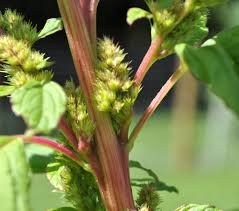Introduction:
Stem amaranth is a summer vegetable commonly grown in Bangladesh. It is rich in vitamins A, B, C, D, calcium, and iron, with its leaves being even more nutritious than the stems. This vegetable stands out due to its high content of various vitamins and minerals.
Soil Characteristics:
Stem amaranth thrives in fertile, deep, and well-drained soils. ‘Zoe’ soil is particularly well-suited for its cultivation.
Production Techniques:
Stem amaranth is primarily cultivated during the dry season. While it can also be grown in the due to the mild winter, it is less common as many other vegetables are available during that time.
Land Preparation:
- Tilling: Prepare the land by deep harrowing and finessing to ensure there are no large clods or waves in the soil.
- Spacing: For varieties that are stem dominant, space rows 30 cm apart. Gradually thin the plants after sprouting to ensure that in the end, two plants are 8-12 cm apart within a row.
- Thinning: For varieties with thick and long stems and late flowering, ensure proper thinning.
Seed Requirements:
Approximately 15 grams of seed per cent of land is needed for stem amaranth cultivation.
Sowing the Seeds:
- Plowing: Deeply plow the land and break up large furrows to loosen the soil.
- Drawing Lines: Draw lines 1.0-1.5 cm deep with a stick in the rows.
- Sowing: Sow the seeds in lines and cover them lightly with soil. Mixing seeds with an equal amount of ash or fine sand helps distribute them evenly.
- Watering: If the soil lacks moisture, sprinkle water lightly through a sieve to encourage quick and even germination.

Interim Care:
- Weed Control: Keep the land free from weeds to promote healthy plant growth.
- Irrigation: Ensure proper irrigation to prevent the stems from desiccating, which can reduce quality and yield.
- Soil Maintenance: Break and compact the soil to facilitate plant growth and prevent foot rot disease.
- Thinning: Thin the seedlings periodically after about 7 days of growth, keeping plants 5-10 cm apart depending on the variety. Use the thinned seedlings as vegetables.
- Fertilization: Apply urea fertilizer at the appropriate time for this fast-growing crop.

Harvesting:
- Timing: Harvesting time is flexible for stem-bearing varieties, typically done before the plant flowers. The plant is ready for harvest when the stem breaks easily in the middle, indicating a fiber-free state.
- Collection: Regularly check the stems and harvest at the optimal time for the best quality.
Lifetime:
Different stem amaranth varieties have a lifespan of 25-40 days from sowing to harvest.
Yield:
Stem amaranth is a high-yielding vegetable, with scientific cultivation of improved varieties potentially .
By following these cultivation techniques, farmers can achieve high yields of nutritious stem amaranth, contributing to food security and dietary diversity in Bangladesh.

